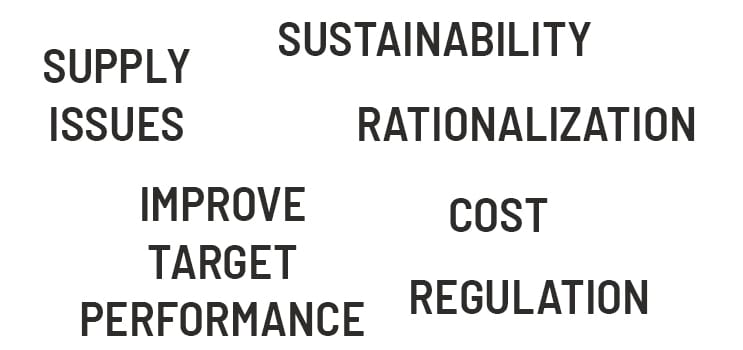The formulations industry moves fast, and agile recipe development is needed to win contracts and maintain high margins. Over the last 7 years Citrine has worked with leading companies such as Lanxess, Michelin and Showa Denko to help keep them ahead of the market and the competition.
REASONS TO REFORMULATE
Once a formulation is developed, that isn’t the end of the story. New regulations, customer requests, and supply issues necessitate reformulation, with a restricted list of ingredients, new ingredients that haven’t been used before, or new processes to achieve better performance.

QUICK OVERVIEW OF WHAT GOES ON IN THE CITRINE PLATFORM

Information is ingested, structured, and converted to AI-readable data. Design spaces – the set of feasible materials or chemicals to be considered – are defined. These can be defined as a set of ingredients and a processing recipe. AI models are generated using training data and refined using sequential learning. And lastly, the data and predictions are visualized to support target setting and strategy.
CHANGING THE DESIGN SPACE
When a new regulation bans an ingredient, or inventory is rationalized to control costs, then the design space changes. The fundamentals of the project have not changed, the same product is needed, and the same underlying data and AI models in the Citrine Platform can still be used. But now they must be re-run on a new design space.
PATENTED DESIGN SPACE VISUALIZATION
Citrine developed a method to predict and visualize the probability of candidate materials in the design space hitting target properties. This enables R&D decision-makers to quickly assess whether the restriction or addition of particular ingredients will impact the target properties of the formulation, before undertaking additional experiments.

Trade-offs between cost, performance, and inventory can be discussed internally and with the customer using data rather than hunches.
PATENT PENDING ON NEW INGREDIENT FEATURIZATION
Featurization is the process by which a piece of information – such as a chemical formula is converted to associated, critical data, e.g. Atomic weight or interatomic distance. (Citrine has built up a library of descriptors to make these conversions automatically for standard materials and chemicals information objects.) This fundamental data can then be used as an input to AI models. When new chemical ingredients are proposed, their fundamentals are fed into the AI model to see how recipes containing them will perform.
In the case where a new ingredient is being considered, there may be no data about how that ingredient performs. Carrying out experiments to get this data is time consuming and costly. Citrine developed a way to “featurize” new ingredients , which allows R&D or application engineering teams to use AI to assess the impact of the ingredients on the properties of the final product.

WHITE PAPER AND WEBINAR
- The unique challenges associated with AI in the formulations space have been synthesized into a white paper that you can download here.
- You can also watch a recording of a webinar on the topic.